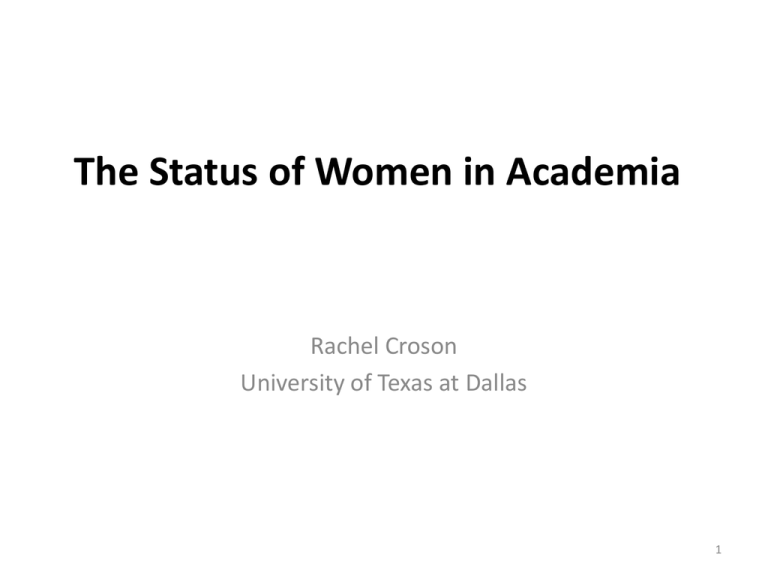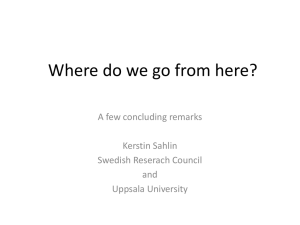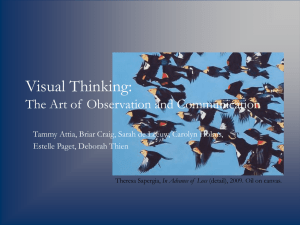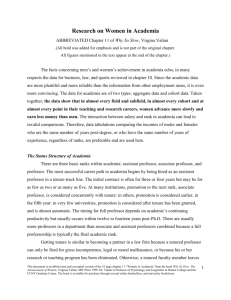Rachel Croson Slides
advertisement

The Status of Women in Academia Rachel Croson University of Texas at Dallas 1 Gender (In)Equity: Women and men in the (academic) workforce • Big picture – Women earn about 2/3 of what men earn for full-time employment around the world – Within a profession and controlling for rank, women earn 10-15% less than men – About 1% of Fortune 500 CEOs are women • Academia – Women PhDs are less likely to choose academic jobs than men – Women academics earn less, have less lab space & other resources – Women are less likely to be granted tenure in every field • In economics, women are 22% of assistants, 15% of associates, 6% of professors; not a pipeline problem 2 Why Gender Equity Matters • Quality – Failing to use the talents and energy of half our population negatively affects the potential quality of future faculty • Legitimacy – Faculty demographics that differ from students’ can carry messages that discourage women from entering the academy, marginalized women faculty exacerbate this effect • Fairness – Aspire to meritocracy, but fail to recognize and reward women’s talents and energies 3 Today’s Talk • Review of others’ work (!) • Documenting gender inequities in academia – Ginther & Kahn (2009, 2006a, 2006b, 2004a, 2004b, 2003a, 2003b, 2002); Ginther & Hayes (1999) • Explaining gender inequities in academia – Valian (1999), Steinpreis, Anders & Ritzke (1999), Wenneras & Wold (1997), Goldin & Rouse (2000), Trix & Psenka (2003) • Suggestions for moving forward (discussion) 4 Ginther and Coauthors • Use 1973 - 2001 Survey of Doctorate Recipients (SDR) – Biennial, Longitudinal Survey of U.S. Doctorates – Used by NSF to analyze scientific labor force – Includes Humanities 1977 – 1995 • Tenure-track or tenured academics (not practitioners) 5 Fields Covered • Life Science – Agriculture and Food Science, Biology • Physical Science (together “Science”) – Chemistry, Earth Science, Physics • Engineering • Social Science – Economics, Psychology, Sociology, Anthropology, Political Science • Humanities – History, Philosophy, English, Modern Languages, 6 Classics, Fine Arts Controls in Analyses • Academic field • Degree institution characteristics • University/College employer characteristics • Rank and Tenure status • Primary work activities (research/teaching) • Government Support of Research • Publications (number vs. quality) 7 Representation • Good: Social science (except economics), humanities, life-science • Not-so-good: Physical science, Economics • Ugly: Engineering 8 Figure 1: Percentage of Doctorates Granted to Females, 1974-2004 Suvey of Earned Doctorates Science Life Science Physical Science Engineering Social Science Humanities Economics Percentage Female 60 40 20 0 1970 1975 1980 1985 Year 1990 1995 2000 Source: 1974-2004 Survey of Earned Doctorates 9 Figure 3: Percentage of Tenured Faculty who are Female, by Discipline 60 Percentage Female Economics Statistics Political Science Life Science Physical Sciences Engineering 40 20 0 1975 1980 1985 1990 1995 2000 Year Source: 1973-2001 Survey of Doctorate Recipients 10 Hiring • Gender and Marital / Children status interact • Rates of tenure-track job within 5 years of PhD – Single women are 16% more likely than (all) men – Married women are 17% less likely than (all) men – Married women with children are 20% less likely 11 Promotion • Good: Science, Engineering • Not-so-good: Social science (except economics); humanities • Ugly: Economics 12 Relative Tenure Rates: 10 Years Past PhD 10 Prob. Female Tenured 5 3.9 2.2 0 -1.4 -2.8 -5 -8.1 -10 -8.4 -15 -20 -21 -25 Science Social Science X Life Science Physical Science Engineering Humanities Economics 13 Figure 4--Predicted Survival without Tenure Functions, by Gender and Discipline A. Economics B. Humanities 1.0 0.8 0.6 0.4 0.2 Male Female C. Social Science X 1.0 Predicted Survival Function Predicted Survival Function Predicted Survival Function 1.0 0.8 0.8 0.6 0.6 0.4 0.4 0.2 0.2 0.0 0.0 0 5 10 Years after Ph.D. 0.0 0 15 5 10 Years after Ph.D. 15 E. Physical Sciences D. Life Sciences 1.0 Predicted Survival Function 0.8 0.6 0.8 0.6 0.4 0.6 0.4 0.2 0.4 0.2 0.0 0.2 0.0 5 10 Years after Ph.D. 15 15 1.0 Predicted Survival Function Predicted Survival Function 0.8 5 10 Years after Ph.D. F. Engineering 1.0 0 0 0.0 0 5 10 Years after Ph.D. 15 0 5 10 15 14 Years after Ph.D. Source: 1973-2001 Survey of Doctorate Recipients Salaries • • • • Control for rank Good: Humanities Not-so-good: Social Science Ugly: Sciences and Engineering 15 Gender Gap in Salaries (2001) 25 21 20 19.9 18.2 Percent Gap 17.2 16.9 15 10.9 10 5 0 Science Social Science Life Science Pooled Assistant Physical Science Associate Engineering Full Humanities (1995) 16 Possible Explanations • Marriage and Children – Impacts hiring and promotion, but not salaries • Productivity – Women more productive than men at Research I institutions • Men rewarded more than women for similar productivity levels (see below) 17 Psychological Barriers to Gender Equity • Gender Schemas – Bias in evaluation of women • Balancing work and family – Family leave and other policies 18 Gender Schemas (Valian 1999) • Non-conscious hypotheses about male/female differences that guide everyone’s (men’s and women’s) perceptions and behaviors • Expectations or stereotypes that define “average” members of a group – E.g. Men are instrumental, task-oriented, competent – E.g. Women are nurturing, emotional, and care about relationships • Normal, human brains categorize • More likely to apply them when group or category salience is high Valian 1999, Why So Slow? The Advancement of Women MIT Press 19 Fidell (1970) • Sent 10 one-paragraph descriptions to department chairmen (psychology) – Varied gender in each – Varied other details (e.g. experimental vs. clinical, publication rate, marital status, …) • Asked to judge – The chances of this person getting an offer for a full-time position (1-7) – At what level (Full, Associate, Assistant, Research Associate, Lecturer, Other) 20 Results • 68% response rate (155 responses) – Men are somewhat more likely to get offer – Men get significantly higher-ranked offers (p<.01) – Men ranked somewhat higher • Note: somewhat dated… 21 Probability of Offer (1-7; higher better) 22 Rank of Offer 23 Steinpreis, Anders and Ritzke (1999) • Sent CV (real) to faculty (psychology) – Male/female rookie, male/female tenured • Between-subjects design (one CV/gender only) • 238 male and female academics – Would you hire? – Does applicant have adequate experience? 24 More Likely to Hire Males (p<.001) 25 Independent of Own Gender 26 Other Ratings • Male candidates more likely to have – Adequate research (p<.005), teaching (p<.005), service experience (p<.005) – Even though the CVs are the same! • Concerns about female candidates – Respondents four times more likely to write cautionary comments in the margins of the questionnaire for female candidates • “We would have to see her job talk” • “It is impossible to make such a judgment without teaching evaluations” • “I would need to see evidence that she had gotten these grants and publications on her own” 27 Wenneras & Wold (1997) • Sweden, biomedical academics • Peer-reviewed system of Swedish Medical Research Council (postdoctoral fellowships) – Vita, bio, research proposal – Reviewed by one of 11 evaluation committees – Score of 0-4 on three attributes (multiplied, averaged across reviewers) • Scientific competence • Relevance of the research proposal • Quality of the methodology 28 Data • Scores from 1995 applications – Women scored lower on all three parameters – .25 lower on scientific competence, .13 on relevance, .17 on methodology • Were women less productive (scientifically competent)? – Number of papers, number of first-authors, impact factor of journals, citation count – Calculated total impact factor 29 Results • Regression of competence scores with controls – Male dummy significant; 0.21 extra competence points – Approximately three extra papers in Science or Nature, or 20 extra papers in top specialty journal – Women had to be 2.5x as productive as men to get same score 30 Regression Results 31 Trix and Psenka (2003) • Letters of recommendation for medical school faculty (linguistics) • All letters from successful applicants for faculty in large American medical school 19921995 (312 letters) – Compare letters written for male (222) and female (89) hires 32 Results (existence) • Women more likely to get minimal letters – 15% vs 6% (p=.021); women’s letters were only 84% as long as men’s • Women more likely to have doubts raised – 24% vs 12% (p=.01) • Stereotypical terms – For men • “successful” (7% vs 3%) • “accomplishment or achievement” (13% vs 3%) – For women • “compassionate” (16% vs 4%) • “grindstone” (34% vs 23%) 33 Results (frequency) • Male letters include more instances of “standout” adjectives (excellent, superb, …) – 2.0 vs 1.5 • Male letters more likely to mention “research” multiple times – 62% vs 35% • Male letters more likely to include scientific terminology – 3.3 lines vs 1.9 lines 34 Results (Possessives [his/her]) 35 Results (Possessives [his/her]) 36 Goldin and Rouse (2000) • Auditions of musicians for orchestras – Before 1980, 12% female or less – 1970-1980, start of open auditions – Some in view, some behind screen – Data on applicant pool, advancement, and hiring • Impact of screen on female hiring is significant – Controls for ability, year of audition, instrument played, … 37 38 Summary • Exist many other studies (within and outside academics), supporting gender schemas – E.g. success is due to skill for men and luck for women (Deaux and Emswiller 1974), gender biases are more pronounced under time pressure (Martell 1991), women perceived to be worse leaders (Eagly and coauthors), reliance on qualifications (education vs experience) depends on the pool (Norton et al. 2004)… • Education is the first step (show me the data) • Objective evaluation policies (gender blind?) 39 What to Do? Family/Work Balance • Academic careers are front-loaded – Tenure period coincides with prime childbearing years – Men with children are more likely to get tenure; women are less likely • Women in the workforce means family-friendly policies are more important – Women need them; men with working partners do, too • Recent data shows that women grad students are likely to forego academia because of family concerns • Family friendly policies needed for recruiting and retaining talented faculty 40 Policies • Maternity/Paternity leave – Beyond required 6 weeks – New norm: 1 semester off teaching (1/2 load), 1 year on clock (no penalty) – Decisions: Male/female, Adoption, other lifeevents • Other on-ramps and off-ramps – Half-time appointments, longer clocks, … • Education about biases in evaluation • Mentoring and advising 41 Conclusion and Summary • Gender equity is important (instrumental and ontological) • Some improvements in academia, but still a long way to go – Hiring, promotion, salary differentials – Field-specific (need individualized solutions) • Possible reasons: subtle bias • Solutions ??? 42









